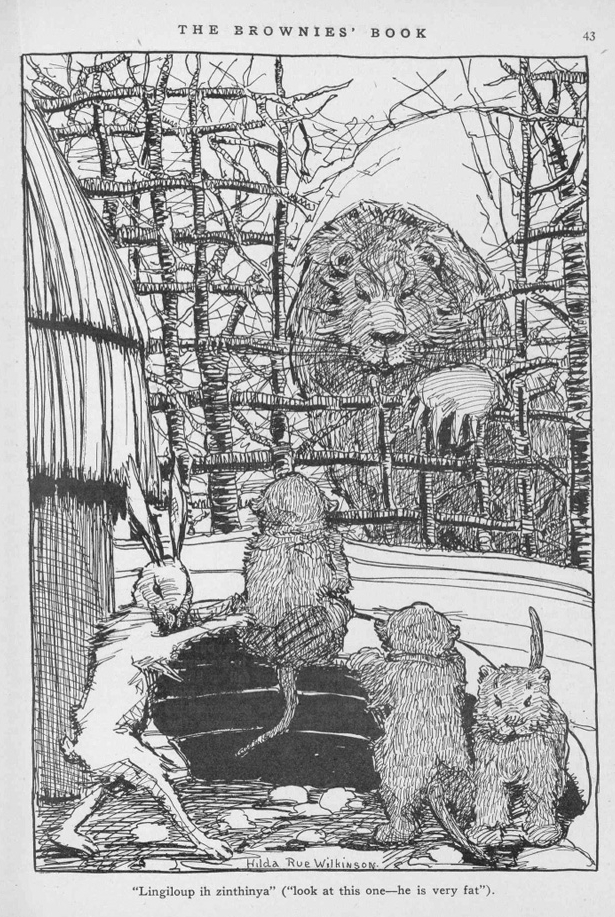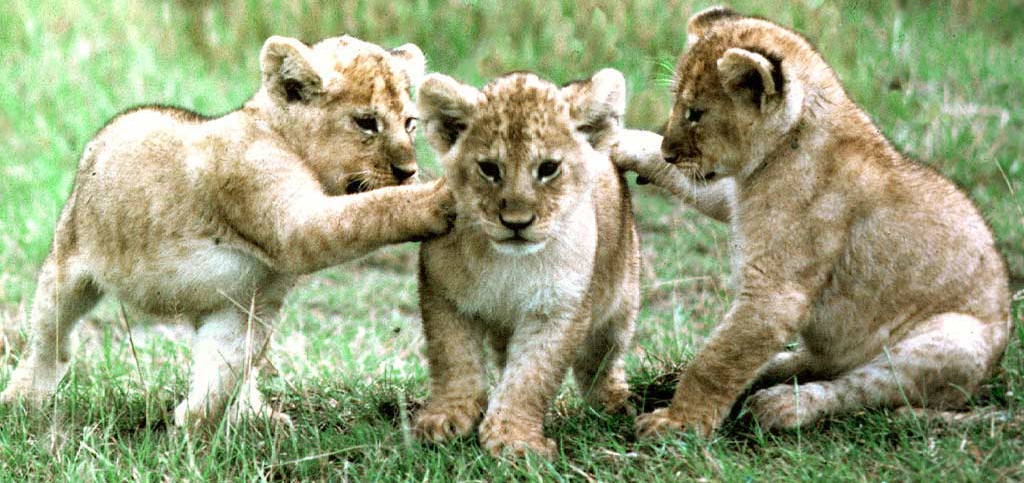Story: Mphontholo ne Shulo ~ The Lion and the Hare: An African Story, published in The Brownies’ Book
Author(s): C. Kamba Simango
Published: February 1921
Internet Archive link.
Notes: I have removed the preface to the story which sets this story in relation in time to the story of Shulo the hare tricking the animals when they built their well. This African story about nursing the lion cubs was told in the Americas about nursing the baby crocodiles.
How Hare Educated the Lion’s Cubs
Mphontholo the lion had heard of the worldwide reputation of Shulo the hare in all the animal world. Shulo had the reputation of being the only person who could think fast enough in any emergency and could think straight and always succeed in finding out or striking upon the right plan that would enable him to overcome the obstacles which confronted him at the moment. He was the father of all tricks and a man possessed of natural ability to use most of his tricks to the best advantage. He outwitted all the animals in playing games as well as in some serious matters of his every day life.
So with this unsurpassed reputation when the three children of Mambo Mphontholo, King Lion, were born, the king and queen could not think of a better person to take care of them than Shulo, who possessed all these marvelous achievements, and to teach their children all that he knew about his art and tricks.
The King Lion sent for Shulo and when Shulo came he was told that the king was going to ask him to take charge of his three children and that he was to devote his time to teaching these children all that he knew about the games and general wisdom. Shulo was to stay with the children in a fenced house. No one was allowed to go in to see the children; even the mother and father were not allowed to come in, but they were to see the children from the outside. The lion was to have meat and other food brought to Shulo and the children every day. Shulo agreed to take of the king’s children, so the next day he began his work with them, teaching them some of the simple games, such as kit hzalano, running after each other; kubaya kata, a ring game; and no kumphuka, hopping game.
When the evening came, King Lion and his wife passed by the house where the children were. They stood on the outside and Shulo lifted each child on the platform so that their parents could see them. The parents asked how the children spent their first day learning the games. “Did all of them behave well with you?” Shulo assured the parents that all three of them did well considering that it was their first time learning the games.
Many days passed and Shulo was at his task teaching the three children. And the father and mother of the children did not fail to bring to Shulo and the children all the best meat they could find. They hunted far and wide and at Shulo’s recommendation certain parts of meat were brought to the children. Every evening the lion never failed to come to inquire after the health and progress of his children and Shulo lifted them on the platform so that their parents could see them.
The hopping game included the jumping of suspended poles, jumping across the trenches and over the blazing flames of fire. One day as Shulo and his pupils were going through their daily gymnastic exercises, jumping across the trenches and over the blazing flames of fire, one of the pupils fell in the blazing fire and was immediately burned to death. Shulo, as he always had done, thought of the way he was going to get out of the trouble. When the evening came, the lion came to inquire after the children’s health and progress. Shulo lifted up the children on the platform. He lifted up one child twice, saying as before, “Lingiloup ih zinthinya,” which means, “Look at this one; he is very fat.” The lion was satisfied to see that the children were getting along nicely.
Two days later the second child also met his death during these daily exercises, so when the evening came Shulo lifted up one child three times, so that the lion could see all three of his children. All three of them were manthikinya, very fat.
The following day the last child also was burned to death while he was trying to jump over the blazing flames of fire. Shulo did not waste time, but he immediately thought of a scheme by which he could rid himself of the extreme difficulty in which he was. So he went about scratching himself up, ruffling his hair and bleeding himself here and there all over his body.
When the evening came, the lion found Shulo outside of the enclosed house, crying. The gate of the house was broken. The lion asked what was the matter. Shulo repeated the sad and heartbreaking story of how the baboons broke the gate and got inside the house and killed all three of the lion’s children and that the baboons almost killed Shulo while he was trying to defend the little ones. The baboons did this to avenge themselves of the wrongs inflicted upon them by the lion and his family.
The lion was enraged beyond measure. He and his wife were bent upon killing all the baboons they could find. That same evening the lion and some of his friends went to the place where the baboons were sleeping peaceably and killed a good many of them. Only a few escaped and these were chased about but they succeeded in effecting their escape by climbing into the trees where the lion could not get them.
The next day a few of the remaining baboons called upon the lion. They wanted to know why he had come to their place and killed some of them. As far as they knew they had not wronged the lion nor any member of his family; in fact it was the lion who had wronged them.
The lion at first would not listen to what the baboons had to say, but finally the baboons and the lion went to see the place where the children had been with Shulo. They looked the place over and found no trace of the baboons having been there at the time the children were killed. The lion told the baboons that he was sorry that perhaps he had killed their friends without justification, but that he had acted upon what Shulo had told him.
The lion suspected Shulo of having killed the children, so he started after Shulo. He found him at his home and without further argument the lion, showing his anger, was ready to jump upon Shulo. He told Shulo that it was he who had killed the children and shifted the murder upon the baboons. With threatening words the lion started towards Shulo who ran as fast as he could away from the lion.
After a chase of several hours the lion was gaining ground. Shulo was tired and he knew that if he continued to run, the lion was going to capture him and kill him. He did not know what to do.
While he was thus puzzled he saw a big rock leaning over. He saw his chance under that rock, so he ran under it and held the rock up with his fore legs. The lion, coming at full speed, came under it. Shulo, immediately, as the lion came under it, said “Chekulu batililinyi buwe linotiwila,” which means, “Sir, hold the rock, or it will fall on us.” The lion felt that keeping the rock from falling, was for his interest as well as it was Shulo’s, so he forgot all about his desire of wanting to kill Shulo and held the rock.
Shulo left the lion holding the rock, saying “Kati walegela buwe lino kuneila,” “If you let go the rock, it will fall on you.” Shulo went away about his business and left the lion holding the rock. The lion stayed under that rock for many days and nights without food or sleep. At last he was so tired, hungry and sleepy that he fell down, half scared that the rock was going to crush him; but he could not hold it any longer. But to his surprise he found that the rock did not fall on him. He dragged himself out from under the rock. What he needed then was to get something to eat before he could resume his chase after Shulo!

Illustration by Hilda Rue Wilkinson
Photo of lion cubs by Daniel Bygott at Flickr https://www.flickr.com/photos/davidbygott/4996524778


Provide Feedback